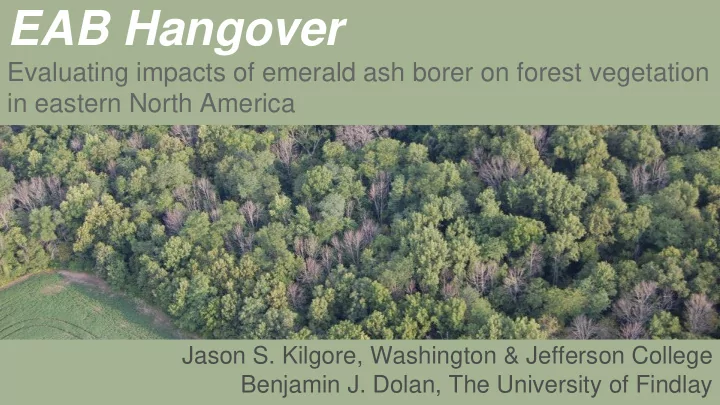

EAB Hangover Evaluating impacts of emerald ash borer on forest vegetation in eastern North America Jason S. Kilgore, Washington & Jefferson College Benjamin J. Dolan, The University of Findlay
emerald ash borer ( Agrilus planipennis )
Impacts of EAB thus far Altered light regime Altered nutrient cycling & carbon storage Blue ash has higher resistance, but still dies Geographical range of blue ash ( F. quadrangulata)
EAB Impacts Study: hypotheses Water stress affects rate of ash decline (continentally) Increased light availability leads to increased seedling density and sapling growth rate Increased light availability in high ash plots leads to shift toward shade-intolerant tree species and more invasive plants Certain invasive plants have a disproportionate effect on post- invasion diversity, growth rate of native trees, and time to canopy closure.
PFPP variables (Plot & Subplot) Trees: (400 m 2 Plot) ● species, tag ● inventory status ● DBH, soundness ● opt: crown class, height 20 m ● tree damage Small Stems: (25 m 2 Subplot) o species, tally 20 m
EAB variables (Plot) EAB Indicators: ● Ash rating ● Ash tree breakup ● EAB exit holes http://vil.carpentersville.il.us/images/EAB/Canopy%20Dieback%20of%20an%20 Ash%20Tree.jpg http://labs.russell.wisc.edu/eab/files/2011/06/D-shaped-exit-holes.jpeg
Understory variables (Subplot) Understory Community: ● Canopy cover ● Shrub/saplings (0.3-1.37 m tall) o Species, tally
Understory variables (Miniplot, 1 m 2 ) Understory Community: ● Woody seedlings and herbaceous plants o Species, tally, cover class
Distribution vectors (GIS) Distances to: ● Major roads and expressways ● Streams and rivers ● Railroads ● Shipping ports ● Distribution centers and manufacturers receiving goods on foreign pallets
Baseline data: Collection effort
Baseline data: Miniplot diversity
Initial results: mature ash UF (Ohio) and W&J (Pennsylvania) ● Similar mature ash density (67-71 trees/ha) and overstory (22%) ● EAB documented in Hancock County (2005) and Washington County (2009) ● Ash mortality higher at UF (99%) than W&J (0%, but 23% with EAB symptoms)
Data collection & curriculum Undergraduate students ● General ecology, field biology, etc. ● Upper-level ecology or research courses Understory variables ● May – July
Student outcomes Science literacy Collaboration Conferences ● College, regional, national (BSA, ESA)
Future Do you have ash? Community data analyses (Spring 2016) ● Conferences (BSA/ESA) ● Manuscripts
Recommend
More recommend